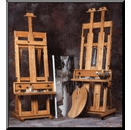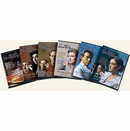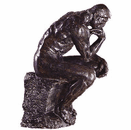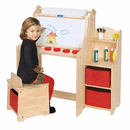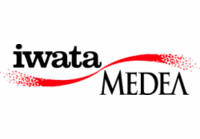Triggering Tips
Triggering for Freehand Airbrushing
When airbrush technique comes to mind, many artists envision elaborate processes where stencils and frisket film, found objects, and secret techniques are employed to develop images. In reality, however, many artists utilize nothing but the manipulation of the airbrush to develop their images, e.g. the portraiture of Chuck Close and the fabric designs of Jurek.
To develop competency in strictly freehand airbrushing, much practice is required, primarily the same type of practice that is used in the basics of airbrushing. This entails spraying dots, lines, and gradations after learning the triggering techniques and becoming familiar with the manipulation of the air source for a variety of effects.
To start, triggering is important, and we will assume that the student is at a basic level and is using a dual-action airbrush.
1. First, make sure the airbrush is held correctly (like a pen or pencil). Then depress the trigger completely to release air; and pull back on the trigger (while depressed) to release paint. Start practicing dots by pressing down for air, pulling back for paint, and then releasing the trigger to shut off both air and paint. Listen to the spray--on/off. Look at the dot that is developed. The closer you are to the surface of the work, the smaller the dot; and the further back you pull the trigger, the more paint comes out. Practice spraying until you have the command of spraying small dots; and then large dots. Take grid paper and spray dots inside the squares.
2. Once you feel comfortable with the on/off triggering, move on to triggering the airbrush by pressing down on the trigger for air, pulling back for paint, and then pushing the trigger forward to a shut off position while the air is still on; then removing your finger from the trigger to shut off the air. Use this system of triggering to develop dots within your grid paper.
3. Now that you have become familiar with the forward and backward method of triggering, move on to the method that you will utilize in all your freehand work. Depress the trigger for air; pull back for paint; spray your dot; move your finger forward to shut off the paint; pull the finger back for more paint without shutting off the air. If you have had the opportunity to watch a professional T-shirt painter working on a boardwalk or in a mall, you will notice that the air is constantly on.
4. Another method of triggering is to press down for air and pull back for paint; when you reach the point that gives you the volume of spray you require, you can keep the trigger at that position and control the on/off of the paint by allowing the trigger (which is spring-loaded) to pop up at that position for shut-off. Then you can simply push down for that same amount of paint each time. Again, spray dots into your grid.
Experiment and become comfortable with all the methods of triggering that you can utilize when needed.
Once you are settled into your preferred method, you can begin to practice line work, dagger strokes, and gradations that will be used in developing your picture without the use of stencils.
When airbrush technique comes to mind, many artists envision elaborate processes where stencils and frisket film, found objects, and secret techniques are employed to develop images. In reality, however, many artists utilize nothing but the manipulation of the airbrush to develop their images, e.g. the portraiture of Chuck Close and the fabric designs of Jurek.
To develop competency in strictly freehand airbrushing, much practice is required, primarily the same type of practice that is used in the basics of airbrushing. This entails spraying dots, lines, and gradations after learning the triggering techniques and becoming familiar with the manipulation of the air source for a variety of effects.
To start, triggering is important, and we will assume that the student is at a basic level and is using a dual-action airbrush.
1. First, make sure the airbrush is held correctly (like a pen or pencil). Then depress the trigger completely to release air; and pull back on the trigger (while depressed) to release paint. Start practicing dots by pressing down for air, pulling back for paint, and then releasing the trigger to shut off both air and paint. Listen to the spray--on/off. Look at the dot that is developed. The closer you are to the surface of the work, the smaller the dot; and the further back you pull the trigger, the more paint comes out. Practice spraying until you have the command of spraying small dots; and then large dots. Take grid paper and spray dots inside the squares.
2. Once you feel comfortable with the on/off triggering, move on to triggering the airbrush by pressing down on the trigger for air, pulling back for paint, and then pushing the trigger forward to a shut off position while the air is still on; then removing your finger from the trigger to shut off the air. Use this system of triggering to develop dots within your grid paper.
3. Now that you have become familiar with the forward and backward method of triggering, move on to the method that you will utilize in all your freehand work. Depress the trigger for air; pull back for paint; spray your dot; move your finger forward to shut off the paint; pull the finger back for more paint without shutting off the air. If you have had the opportunity to watch a professional T-shirt painter working on a boardwalk or in a mall, you will notice that the air is constantly on.
4. Another method of triggering is to press down for air and pull back for paint; when you reach the point that gives you the volume of spray you require, you can keep the trigger at that position and control the on/off of the paint by allowing the trigger (which is spring-loaded) to pop up at that position for shut-off. Then you can simply push down for that same amount of paint each time. Again, spray dots into your grid.
Experiment and become comfortable with all the methods of triggering that you can utilize when needed.
Once you are settled into your preferred method, you can begin to practice line work, dagger strokes, and gradations that will be used in developing your picture without the use of stencils.
Copyright © 2002-2025 Madison Art Shop™ LLC. All Rights Reserved.


